Speech The Domestic Outlook and the Role of Mining

Alexandra Heath
[*]
Head of Economic Analysis Department
Address to the NSW Mining Industry & Suppliers Conference
NSW Parliament House, Sydney –
- Audio 11.1MB
- Q&A Transcript
The mining industry has been an important part of the New South Wales and Australian economies for a very long time. Coal from New South Wales was Australia's first commodity export and continues to make a significant contribution to Australia's exports over two hundred years later. Gold was first discovered in New South Wales in the early 1850s and BHP was founded in Broken Hill in the 1880s.
Today I am going to give a brief overview of how the mining boom has affected the domestic economy over the past decade before considering the forces currently at work in the mining industry and how they might affect the domestic economy going forward. As a central banker, my normal focus is on the outlook for the domestic economy over the next couple of years. But there are much longer-lived structural forces at work as well as short-run factors. In recognition of this, I will finish up by examining some longer-run trends in demand associated with the economic development of China.
The Role of Mining over the Past Decade
Developments in the mining industry have played a very important role in the dynamics of the Australian economy over the past 10 years or so.
The increase in demand for raw commodities from emerging economies over the 2000s took many, including the Reserve Bank, by surprise. However, as many in the audience will know, it takes some time to ramp up large investment projects, so supply could not keep up with the rapid increase in demand and the result was a substantial rise in commodity prices over a number of years (Graph 1).
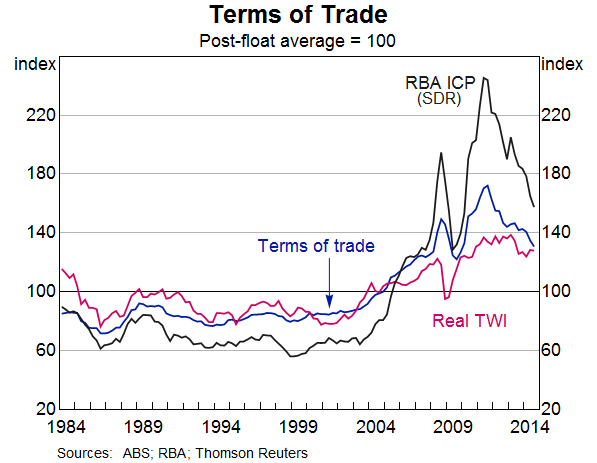
The rise in commodity prices has had many positive effects on the Australian economy. First, the Australian terms of trade increased to historically unprecedented levels. This boosted the purchasing power of domestic income. Also, as usually happens, the terms of trade increase was accompanied by an exchange rate appreciation. This effectively redistributed some of the benefits of the rise in the terms of trade to the broader community in the form of lower import prices.
Second, the rise in commodity prices sparked a substantial rise in mining investment. Prior to the boom, mining investment was around 2 per cent of GDP and it peaked at almost 8 per cent of GDP in 2013 (Graph 2). This clearly had a direct benefit to those who were able to get jobs in the mining industry, but there were significant spillovers because this investment generated demand for goods and services from other parts of the economy that are not classified as mining per se, such as manufacturing and business services. Bank research estimates that resource-related activity is much more labour intensive than resource extraction and probably accounted for almost 7 per cent of employment in 2011/12, from around 2½ per cent in 2003/4 (Rayner and Bishop 2013).
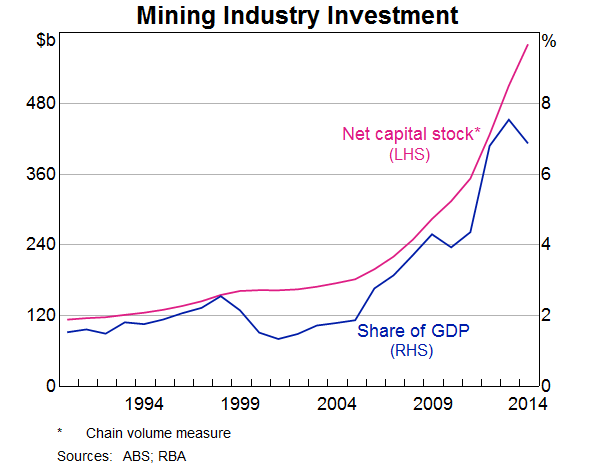
Recent research by colleagues at the Bank estimates that the total effect of the mining boom boosted living standards, as measured by real per capita household disposable income, by more than 10 per cent over the decade to 2013 (Downes, Hanslow and Tulip 2014).
The Near-term Outlook
The Australian economy is in transition from the investment phase of the mining boom to the production phase. We have now seen the peak in mining investment and over the near term we expect that the fall in mining investment will be a significant drag on GDP growth. There is, however, some uncertainty around how fast and how far mining investment will fall and the extent to which investment in operational aspects of mining projects will contribute to growth.
The expansion in production capacity for iron ore and coal has already had a direct effect on Australia's exports, which have made a significant contribution to real GDP growth over the past year or so (Graph 3). Iron ore and, to a lesser extent, coal exports are expected to continue to make a positive contribution to GDP growth in the next couple of years as productive capacity continues to ramp up. LNG production capacity will also start coming on line over the next year, which will provide another significant boost to resource exports.
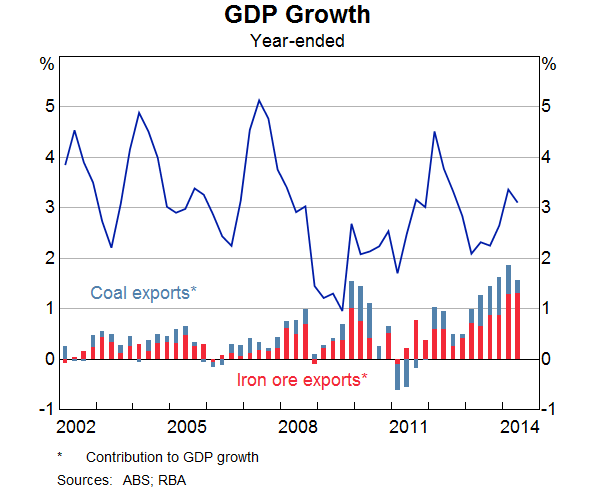
The increase in Australia's production capacity has boosted the global supply of iron ore and coal, as has the increase in production capacity in a number of other countries that have responded to the same fundamentals. Much of the fall in iron ore and coal prices we have seen over the past year or so is the result of increasing global supply, but recently there has also been some easing in demand associated with slower growth in Chinese steel production. The resulting fall in Australia's terms of trade is expected to weigh on household income. Just as the rise in the terms of trade was accompanied by an appreciation of the exchange rate, their fall has been accompanied by a depreciation. Our assessment is that, despite the depreciation since early 2013, the Australian dollar remains above most estimates of its fundamental value.
The transition from the investment phase to the production phase of the mining boom is a significant structural change and there are likely to be distributional effects. There will be a decline in mining employment, and the types of labour required to maintain production of an operating mine or LNG train can be quite different to the labour required in the investment and construction phase. Having said that, information obtained from our business liaison program suggests that many of the people employed in the investment phase of the mining boom had previous experience in the construction industry and many of these people are expected to return to the construction sector (Doyle forthcoming). That is not to downplay the challenges related to the fact that these opportunities are in different parts of the country.
The question of what might happen to commodity prices in the longer-run will depend on the dynamics of global supply and demand. It is hard to know how they will play out, but we can say something about some of the longer-term forces that are likely to affect demand for our commodity exports. In the time that remains, I will talk about some of the main longer-term drivers of Chinese demand for commodities, which currently accounts for a bit over 40 per cent of our commodity exports.
The Longer-term Outlook for Chinese Demand
Chinese GDP growth has been easing from the rapid pace seen over the past decade or so to a little less than 7½ per cent. Unless productivity growth is particularly strong, supply-side factors such as the declining working-age population will make it harder for China to maintain this growth over time. This will affect the demand for commodities produced in Australia and elsewhere. Yet, even if the sustainable growth trajectory for the Chinese economy gradually declines over the medium term, the economy is much larger than it was and is still growing. This implies there will continue to be a huge appetite for commodities of many kinds. Some of this demand can be satisfied by local Chinese production, but given the competitiveness of Australian production in a number of commodities, China is likely to be a large market for Australian resource exports for some time to come.
We also know that the nature of growth in China is changing as the economy evolves and matures. One of the driving forces of this change has been the process of urbanisation. Between the early 1990s and today, the proportion of the Chinese population living in urban areas has doubled (Graph 4). Projections based on data from international organisations suggest that China's urbanisation process still has some way further to run, though the pace is likely to slow.
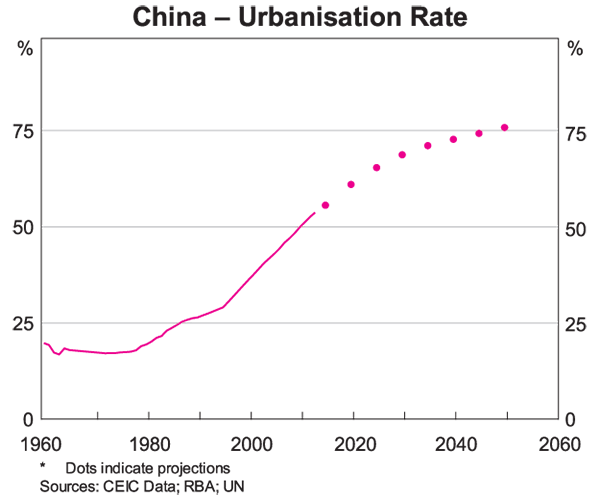
Urbanisation has had a huge impact on China's demand for commodities. This process tends to be accompanied by increases in the amount of food consumed and its calorific and protein content. It also leads to a huge increase in demand for commodities to build housing, infrastructure, utilities and public buildings. Work by researchers at the Bank suggests that the peak in steel demand for the construction of housing is likely to occur later than the peak in residential construction. This is because the steel intensity of Chinese construction has been increasing over time as a result of buildings becoming taller and having features like underground parking (Berkelmans and Wang 2012). For example, a 50-floor building requires roughly double the amount of steel per square metre as a 15-floor building (Walsh 2011).
As the economy matures, consumption is likely to become a more important driver of growth. Estimates based on data from 2011 suggest that Chinese investment uses output from the Australian mining industry much more intensively than Chinese consumption (Kelly forthcoming). However, just as components of investment such as housing construction are likely to become more commodity intensive, so too will some important components of consumption. For example, motor vehicle use in China is still very low by international standards, but as cities grow and incomes rise, this is likely to become a more important source of steel demand (Graph 5).
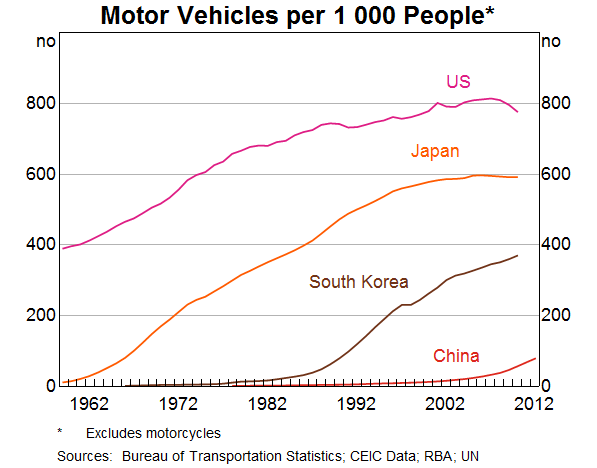
China's per capita energy consumption is also currently low relative to that in many advanced economies. This suggests that Chinese energy consumption will increase as the economy develops. The question is then, how will this increase in demand be satisfied?
China's energy consumption is currently heavily tilted towards coal. In 2013, coal accounted for two-thirds of China's energy consumption (Graph 6). Until the late 2000s, nearly all of this demand was satisfied by coal produced in China. However, in recent years there has been a surge in Chinese coal imports that is likely to reflect the fact that steel production has grown rapidly and there has been a fall in the cost of globally supplied coal relative to the cost of coal production in China. The sheer size of Chinese demand for coal means that although China's imports of coal still amount to less than 10 per cent of domestic coal consumption, they account for almost one-quarter of the global trade in coal.
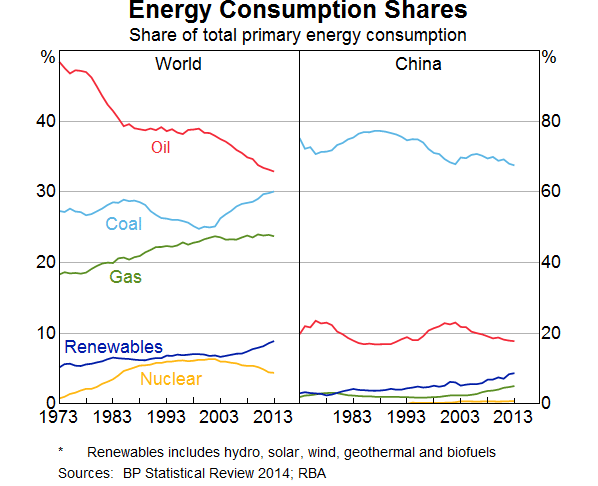
But the Chinese authorities have expressed concerns about air pollution and carbon emissions more generally. One recent manifestation of this was the joint announcement by China and the United States on carbon emissions. The effect of policies designed to address these concerns could put downward pressure on coal consumption in China, but the implications for Australia's coal export volumes will depend on a number of factors including relative prices and competitiveness of our producers.
Unlike other fossil fuels, the Chinese Government is actively pushing to increase the share of gas in domestic energy consumption.[1] It is doing this by increasing the use of pipeline gas and LNG imports as well as tapping China's own, potentially substantial, reserves of unconventional gas. Consumption of LNG in China has more than quadrupled in the space of a decade, and China is now the third largest importer of LNG. Most of this has been the result of an increase in demand for industrial use, but residential consumption has also been rising quickly. This trend in itself is positive for the outlook for Australian LNG exports, but its significance will very much depend on the price and availability of all sources of energy commodities in the years to come.
Conclusion
In conclusion, just as the mining investment boom spurred by high commodity prices had a substantial impact on the Australian economy, so too will the transition from the investment phase to the production phase. The dramatic increase in Australia's capacity to export commodities, along with similar responses from other resource producers around the globe, has increased global supply relative to global demand to the point where prices for these commodities have fallen. Supply will continue to respond to, and affect, commodity prices, and while the growth of Chinese demand is slowing, many of the long-term drivers of the original increase in demand for commodities from China are still in play. The Chinese economy is continuing to evolve in ways that will support demand for resources, and the sheer size of the economy suggests that these demand forces will, over the medium to long term, remain strong.
Endnotes
I would like to thank Natasha Cassidy, Ivan Roberts and other colleagues at the Reserve Bank of Australia for their help in preparing this presentation. [*]
Natural gas produces 370 grams of carbon dioxide per kilowatt hour, compared with 640 grams in the case of crude oil and 720–940 grams for coal (Jacobs 2011). [1]
Bibliography
Berkelmans L and H Wang (2012), ‘Chinese Urban Residential Construction to 2040’, RBA Research Discussion Paper No 2012-04.
Downes P, K Hanslow and P Tulip (2014), ‘The Effect of the Mining Boom on the Australian Economy’, RBA Research Discussion Paper No 2014-08.
Doyle M-A (forthcoming), ‘Labour Movements During the Resources Boom’, RBA Bulletin.
Jacobs D (2011), ‘The Global Market for Liquefied Natural Gas’, RBA Bulletin, September, pp 17–27.
Kelly G (forthcoming), ‘Chinese Rebalancing and Australian Exports’, RBA Bulletin.
Rayner V and J Bishop (2013), ‘Industry Dimensions of the Resource Boom: An Input-Output Analysis’, RBA Research Discussion Paper No 2013-02.
Walsh S (2011), ‘New Opportunities for Industry Growth’, Presentation to Metal Bulletin Conference ‘China Iron Ore 2011’, Beijing, 23–24 March. Available at <http://www.riotinto.com/investors/presentations-91_2369.aspx>.